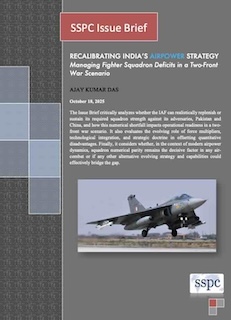RECALIBRATING INDIA’S AIRPOWER STRATEGY: Managing Fighter Squadron Deficits in a Two-Front War Scenario

INTRODUCTION
In 2016, Air Chief Marshal Birender Singh Dhanoa sounded a warning about the Indian Air Force’s (IAF) steadily depleting fighter squadron strength. The IAF has long maintained that a minimum of 42 fighter squadrons is essential to effectively engage both of India’s primary adversaries, China and Pakistan, simultaneously. Interestingly, the following year, Dhanoa reassured that the IAF had formulated a “Plan B” to counter both fronts even with reduced operational strength. His successor, Air Chief Marshal R.K.S. Bhadauria, reiterated this confidence in 2020, declaring the IAF’s readiness for a two-front war in the immediate aftermath of the Galwan Valley clash. A year later, Air Chief Marshal V.R. Chaudhari echoed similar sentiments, emphasizing preparedness despite numerical constraints. Yet, the issue of squadron strength and the feasibility of a credible two-front response continues to loom large over India’s air power calculus. Several defence affairs experts argue that the IAF requires at least 50 squadrons, eight more than the sanctioned strength, to maintain a robust deterrent posture. Current projections, however, indicate that at the prevailing rate of attrition, the IAF may be reduced to merely 26 squadrons in the coming years.
The Issue Brief critically analyzes whether the IAF can realistically replenish or sustain its required squadron strength against its adversaries, Pakistan and China, and how this numerical shortfall impacts operational readiness in a two-front war scenario. It also evaluates the evolving role of force multipliers, technological integration, and strategic doctrine in offsetting quantitative disadvantages. Finally, it considers whether, in the context of modern airpower dynamics, squadron numerical parity remains the decisive factor in any air-combat or if any other alternative evolving strategy and capabilities could effectively bridge the gap.